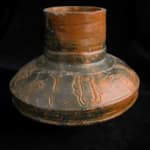Toltec Plumbate Vessel with Incised Glyphs, 900 CE - 1200 CE
Plumbate
6 x 5.5
PF.2544
Further images
The Toltec civilization first gained ascendany in the Valley of Mexico around 900 A.D., after the fall of Teotihuacan. Although their origins and early history are obscure, the Toltecs appear...
The Toltec civilization first gained ascendany in the Valley of Mexico around 900 A.D., after the fall of Teotihuacan. Although their origins and early history are obscure, the Toltecs appear to have ancient ties to both the Mixtec and the Zapotec. The word Toltec means “master builders” in the Nahuatl language, a testament to the sophistication of Toltec constructions. Their art and architecture was highly influenced by Teotihuacan as well as the ancient Olmec culture. The Toltecs were technologically advanced, capable of smelting metals. Their stonework was impeccable as the ruins of Tula demonstrate. This archaeological site is believed to be Tollan, the legendary capital of the Toltec civilization referred to in a number of postconquest sources. Their social structure was headed by an elite class of warriors. Excavation have uncovered the ceremonial center that included a pyramid structure topped by a temple dedicated to the hero-god Quetzalcoatl.
This stunning Toltec vessel, known as plumbate ware, is distinguished by its attractive glassy luster, which was produced by covering the vessel in a slip high in iron and aluminum content and then firing the pot at high temperatures. Greatly prized as a luxury item, plumbate vessels such as this formed a unique component in the repertoire of Mesoamerican art. During the height of the Toltec civilization, plumbate works were produced at only one place: on the Pacific slope of the Soconusco region in modern Guatemala. Furthermore, the process by which it was made seems to have been a closely guarded secret. Such wares were highly valued throughout Mesoamerica and were traded along commercial networks that extended as far as Panama. Plumbate was so desirable in part because it maintains an exceptional hardness that can be scarcely scratched with steel.
This stunning Toltec vessel, known as plumbate ware, is distinguished by its attractive glassy luster, which was produced by covering the vessel in a slip high in iron and aluminum content and then firing the pot at high temperatures. Greatly prized as a luxury item, plumbate vessels such as this formed a unique component in the repertoire of Mesoamerican art. During the height of the Toltec civilization, plumbate works were produced at only one place: on the Pacific slope of the Soconusco region in modern Guatemala. Furthermore, the process by which it was made seems to have been a closely guarded secret. Such wares were highly valued throughout Mesoamerica and were traded along commercial networks that extended as far as Panama. Plumbate was so desirable in part because it maintains an exceptional hardness that can be scarcely scratched with steel.









